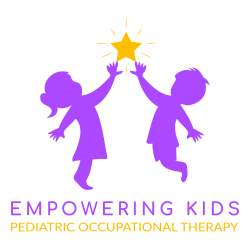Frequent Questions
General Questions
How does occupational therapy help children?
“Occupational therapy practitioners work with children, youth, and their families, caregivers, and teachers to promote active participation in activities or occupations that are meaningful to them. … For children and youth, occupations are activities that enable them to learn and develop life skills (e.g., preschool and school activities), be creative and/ or derive enjoyment (e.g., play), and thrive (e.g., selfcare and relationships with others) as both a means and an end. … Recommended interventions are based on a thorough understanding of typical development, the environments in which children engage (e.g., home, school, playground) and the impact of disability, illness, and impairment on the individual child’s development, play, learning, and overall occupational performance.
“The primary occupations of infants, toddlers, and young children are playing, learning, and interacting with caregivers and, eventually, their peers. Occupational therapy interventions address developmental milestones such as (but not limited to), facilitating movement to sit, crawl, or walk independently; learning to pay attention and follow simple instructions; developing the ability to eat, drink, wash, and dress independently; learning to cope with disappointment or failure; reducing extraneous environmental stimuli, such as noise for a child who is easily distracted; building skills for sharing, taking turns, and playing with peers; using toys and materials in both traditional and creative ways; and participating in age appropriate daily routines.
“Occupational therapy practitioners have training in psychosocial and mental health conditions and are well suited to address children’s emotional and behavioral needs as they relate to everyday activities and social interactions.”
From the American Occupational Therapy Association (AOTA) Fact Sheet, The Role of Occupational Therapy with Children and Youth. Copyright 2015 by AOTA.
Who can benefit from occupational therapy services?
Occupational therapy uses a variety of therapy methods to help children’s development in the areas of motor, sensory processing, social-emotional, learning and behavior. Many children who benefit from services do not have a specific medical diagnosis or educational eligibility.
What are the signs that my child would need occupational therapy services?
(Note the below lists are some examples of concerns that OT’s can help address.)
All children grow at their own developmental pace. If your child is having difficulty gaining a few skills in any area, you can consult with an occupational therapist. Please see more detailed list of signs of concerns in motor, sensory, learning, social, and self-care in the Resources Section.
- My child is gaining developmental motor milestones at a slower rate (e.g. rolling, sitting, crawling, walking, climbing, riding a bike, puzzles, pre-writing/writing).
- My child’s learning is below their grade level.
- My child’s play, social, and emotional abilities are below age expected behaviors.
How do I know if occupational therapy can help my child?
Ask the therapist through the Contact section. You will receive a response within 24 hours to set up a free consultation to discuss your concerns for your child’s development and if an OT assessment would be appropriate.
Does my child need an assessment?
A comprehensive assessment by a qualified therapist is the cornerstone to establish a baseline of where your child’s abilities lay. From here, the therapist will collaborate with the family and child to establish desirable goals for the child to achieve.
What type of therapy methods/interventions are offered?
The highly experienced occupational therapist uses multiple of therapy methods each therapy session customized to meet your child’s specific needs. Therapy methods may include:
- Ayres Sensory Integration®️
- Zones of Regulation®️
- The Listening Program®️
- Learning Without Tears (including Get Set For School®️, Handwriting Without Tears®️, Keyboarding Without Tears®️)
- Social Thinking®️
- Neurodevelopmental Treatment (NDT)
- Assistive Technology
- SCERTS®️ Model
- Oral Motor approaches (e.g. Beckman)

